|
|
Churches of Olinda
« Map of Historic Center of Olinda
« More information about Olinda
«Recife
«Pernambuco
Olinda is known by the culture, the carnival and the churches.
Many churches of Olinda date back to the times of the foundation of the city, in the 16th century. At that epoch, the Roman Catholic Church was facing the ideas of Marthin Luther and other Reformists; the Catholic Kings of Portugal, to evangelize as many souls (Indians and blacks) as possible in the New Continent, stimulated several religious orders to come to Olinda (read History of Olinda).
The Dutch captured the city in 1630, and in 1631 all the Churches were burned down. Instead of lessening the Catholic faith, this act of intolerance, as it usually happens, seem to have given more strenght to the Catholics.
After the Dutch were expelled, most churches were rebuilt. Over the centuries, the churches needed restorations, but most of their History was preserved.
Below, some info about the important churches of Olinda.
Igreja dos Milagres - Church of Miracles
 A legend goes that, during a time of drought, a cow found a natural water source in the middle of the mangrove, which was considered to be a miracle.
A legend goes that, during a time of drought, a cow found a natural water source in the middle of the mangrove, which was considered to be a miracle.
A well was dig on the place, which supplied water to the city during the drought.
The church, one of the simplest in Olinda, was dedicated in 1862. The area around the church is called Square of Miracles, and the neighbourhood itself is also called Milagres.
Back to top
Mosteiro de São Bento - Monastery of Saint Benedict
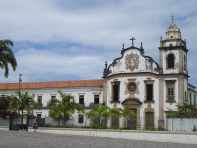
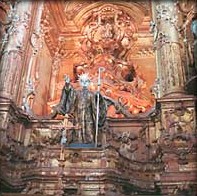
Built by the Benedictins, in the 16th Century.
The date carved in the façade, 1761, indicates the last refurbishment.
The altar is the richest in Olinda, with many gold pieces. In 2003, the altar was exhibited by the Guggenheim Museum; the disassembling of the altar was made by a team of specialists, and took months; read this page of Guggenheim about the São Bento altar, but notice that the text has a few inaccuracies (like the date of building of the church).
The church is the only one in Olinda with a mezzanino. During colonial times, the rich people would attend the mass in the mezzanino, the other free people would stay in the floor, inside the church, and the slaves would stay outside.
It was in the building beside the church that, on May 15th 1828, the first Faculty of Law was established in Brazil (first classes were on June 2nd of the same year). In 1852, the Faculty was transferred to the Palace of Governors, in Olinda, and in 1854 it was again transferred to Recife.
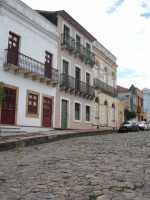 When visiting the Monastery, take also a look at Rua São Bento, which starts in front of the church.
When visiting the Monastery, take also a look at Rua São Bento, which starts in front of the church.
The street itself is still paved with stones from the 16th/17th century; the difference in colors indicate that the stones came from different parts, and fixed in different epochs. Most of the streets were repaved in Olinda; the original stones may be recognized by the irregular laying.
Also, these three houses (photo to the right) are preserved, showing how people used to live. The main difference is in the roof: tiles, made one by one, were a luxury; rich people had a roof with three layers of tiles, the middle class had two layers, the poorer had only one. These three houses are called Eira, Beira and Tribeira; a popular saying in Brazil refers to poor people as being "sem eira nem beira", meaning that, like in the old Olinda, their houses would have only one layer of tiles.
Back to top
Igreja do Carmo - Church of Carmo
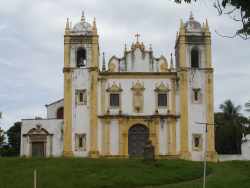
The official name is Church of Saint Anthony of Carmo.
First church of the Order of Carmelites in Brazil; the building started in 1580, the dedication was in 1620.
The main altar has three niches; the central niche has a baroque image of Saint Anthony, and the lateral niches are dedicated to the founders of the Order of Carmelites, Saint Elias and Saint Eliseu.
In the lateral corridors, there are altars with imponent oil paintings.
In early 2006, the church was closed for visitations. The façade is visibly worn out, a much needed restoration job is in progress.
The restoration has been delayed by a controversy: a few years ago, IPHAN, the Brazilian Institute for Administration of National Heritage, set up its Olinda office inside the Church of Carmo. Instead of protecting the church, however, IPHAN was charged of, in the name of the comfort of their staff, promoting changes in the structure of the church in a way incompatible with the original architecture; for example, a large set of stairs was built in iron and concrete to give access to the IPHAN office.
The restoration seems to be going slow.
Back to top
Igreja de São Pedro - Church of Saint Peter
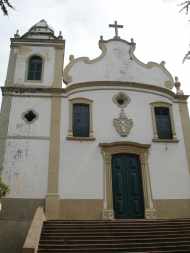
This is called the Church of Saint Peter, the Apostol; the church was built in the second half of the 18th century. The Order of Peter, however, had built another church, in honor of Saint Peter, the Martyr, in 1711, which no longer exists. The Order of Peter also left Olinda.
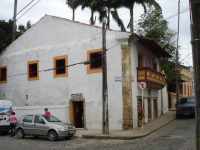 Notice that, in the corner in front of the church, it is still standing what is believed to be "The First House in Olinda" (photo to the right).
Notice that, in the corner in front of the church, it is still standing what is believed to be "The First House in Olinda" (photo to the right).
Of course, the house was refurbished many times. Today, people from Olinda refers to it as "the house where one enters through the door and leaves through the windows". This happens because, after successive pavings of the streets, the level of the terrain was elevated; the windows, which were distant from the floor, are today at floor level, and are used as doors.
Back to top
Igreja da Boa Hora - Church of the Good Time

One of the smallest churches of Olinda. An oratorium was first built in 1750, which evolved to a church by 1760. The inscription 1806 shows the date of the last restoration.
The name "Good Time" is a euphemistic reference to the time when a person dies. Probably, the church was used as mourning place in the past.
Back to top
Igreja da Misericórdia - Church of Mercy
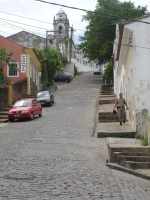
Official name is Church of Our Lady of Luz (Luz is the Portuguese word for Light, illumination).
The Church and the hospital were built in 1540; the hospital was called Santa Casa de Misericórdia (Holy House of Mercy), and was the first hospital in Brazil.
The church is located at the Alto da Misericórdia (Heights of Mercy), towards the higher part of Olinda. Access is usually by the Ladeira da Misericórdia (Ladder of Mercy), which is the steepest hill in Olinda. The ladder is paved with cobbled stones (from colonial times), which get slippery when wet; notice that even though there is a stairway in the sidewalk, the olindenses advise to walk up the streets, which would be less tiring.
The Church has the second richest altar of Olinda, second only to the Monastery of São Bento. From the floor to the ceiling, the altar is adorned with masterpieces.
Near the main gate, there is a wall with Portuguese tiles from the 17th century.
Back to top
Igreja da Conceição - Church of Conception
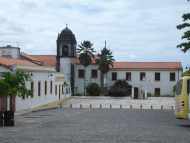 Church and convent of Our Lady of Conception. Built in the 16th century, but abandoned during the Dutch period. For centuries, the convent served as shelter for abandoned women.
Church and convent of Our Lady of Conception. Built in the 16th century, but abandoned during the Dutch period. For centuries, the convent served as shelter for abandoned women.
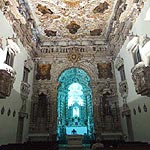 The original altar is gone, but the walls and ceiling still exhibit magnificent paintings of Our Lady, with details in polycromatic gold.
The original altar is gone, but the walls and ceiling still exhibit magnificent paintings of Our Lady, with details in polycromatic gold.
Currently, the convent is home of the Irmãs Dorotéas (Doroteas Sisters), the most reclused Order of Olinda; the Sisters can not have any contact with the outside world (not even for medical assistance).
The church is open for visitation, but visits must be arranged beforehand; telephone: 81 - 3429.3108.
Back to top
Igreja da Sé - Church of Sé

Official name: Church of Saint Savior of the World.
Built in 1535. It was turned into a Protestant temple during the Dutch period.
Located in the Alto da Sé, the highest place in Olinda. It was from where today is the backyard of this church that Duarte Coelho, enchanted with the beautiness of his viewing, would have said the phrase which gave name to the city: "Oh, linda situação para construir uma vila" (read more about History of Olinda). This backyard is open for visitation, and is one of the best places to take photos in Olinda.
Since 1676, this has been the cathedral of Olinda and Recife (hence the name, Sé, in Portuguese).
Even though not supposed to, the interior of the church is like a museum. Pieces of the History of the church are exposed in small niches along the lateral corridors. These pieces include paintings (the painting above is said to be have been painted with the same technique used by da Vinci in Mona Lisa), bells, statues, altars.
The columns which hold the church were built with rock brought from the reefs. Despite several refurbishments of the church, it is believed that some columns are still the original ones from the 16 th century.
Back to top
Igreja do Amparo

Official name: Church of Our Lady of Amparo (amparo is the Portuguese word for shelter, protection).
The Church was founded by young bachelors and musicians between 1550 and 1560. One of the lateral altars is dedicated to Christ, and the other one is dedicated to Saint Cecília, protector of musicians.
It was burned down by the Dutch in 1631; the date on the façade, 1644, is the start of the reconstruction.
On the first floor of the church is installed the Olinda Laboratory of Restoration, in charge of restoring the city Heritage.
Back to top
Igreja de São João - Church of Saint John
 Official name: Church of Saint John of the Militaries.
Official name: Church of Saint John of the Militaries.
Built during the second half of 16th century. It is a simple church, with only one tower and a humble altar.
This was one of the few churches which escaped from being burned by the Dutch, probably by respect to the Saint, who protects militaries. The church was used as headquarter by the Dutch Army.
Back to top
Igreja do Rosário - Church of the Rosary

Official name: Church of the Rosary of the Black Men of Olinda.
Built in the second half of the 17th century. This was one of the first churches in Brazil to be built by a brotherhood of black slaves; several others exist.
Black slaves could not profess their religions, and could not enter Catholic churches either. Groups of blacks used to meet around the churches and organized a celebration called Congos, a means to maintain their original African beliefs. Over time, the blacks adopted canons of the Catholic church, adapting them to their own religions (in Bahia, State with the highest number of slaves in Brazil, this process of religious syncretism generated new religions, like umbanda and candomblé; read more about religious syncretism in Bahia); in Olinda and Pernambuco, free slaves were allowed to create brotherhoods and build churches.
This church was restored in 1988; during the restoration, the specialists uncovered paintings which resembled the gold and gems used in the altars of the richer churches.
Back to top
| |









 A legend goes that, during a time of drought, a cow found a natural water source in the middle of the mangrove, which was considered to be a miracle.
A legend goes that, during a time of drought, a cow found a natural water source in the middle of the mangrove, which was considered to be a miracle. When visiting the Monastery, take also a look at Rua São Bento, which starts in front of the church.
When visiting the Monastery, take also a look at Rua São Bento, which starts in front of the church. Notice that, in the corner in front of the church, it is still standing what is believed to be "The First House in Olinda" (photo to the right).
Notice that, in the corner in front of the church, it is still standing what is believed to be "The First House in Olinda" (photo to the right).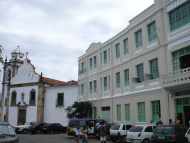
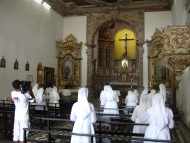
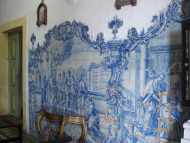
 Church and convent of Our Lady of Conception. Built in the 16th century, but abandoned during the Dutch period. For centuries, the convent served as shelter for abandoned women.
Church and convent of Our Lady of Conception. Built in the 16th century, but abandoned during the Dutch period. For centuries, the convent served as shelter for abandoned women. The original altar is gone, but the walls and ceiling still exhibit magnificent paintings of Our Lady, with details in polycromatic gold.
The original altar is gone, but the walls and ceiling still exhibit magnificent paintings of Our Lady, with details in polycromatic gold.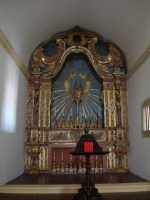
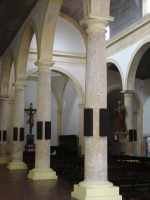
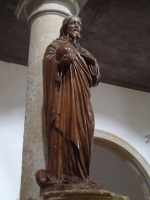
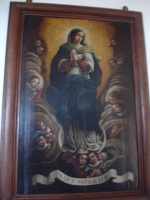
 Official name: Church of Saint John of the Militaries.
Official name: Church of Saint John of the Militaries.